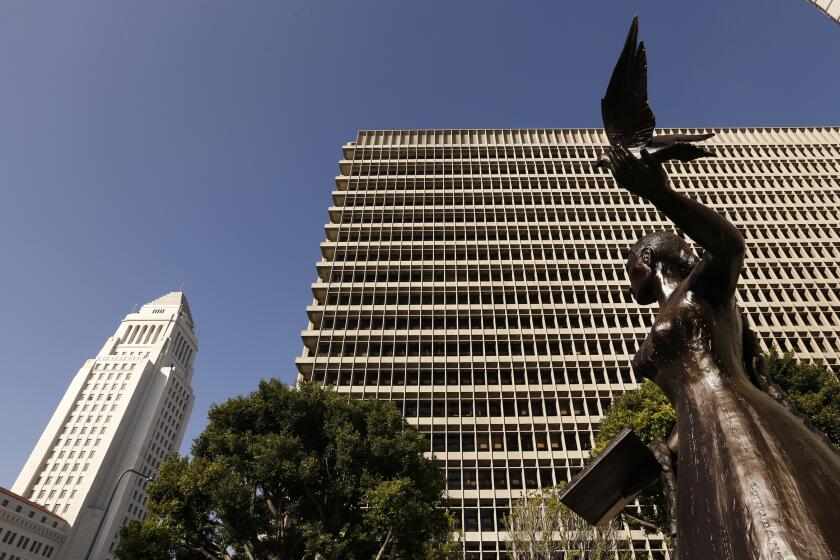California blew it on bail reform. Now Illinois is showing it works

- Share via
California lawmakers passed a bill eliminating money bail in 2018, but voters overturned the important reform in tumultuous 2020 after a fear-stoking referendum campaign led by the bail bond industry. The state is now slowly picking its way through more modest improvements set in motion by court policies and lawsuits, leaving us with a piecemeal system that is too slowly and inconsistently rolling back the role of wealth and poverty in determining who gets out of jail before trial.
That left leadership to other states. The Illinois General Assembly passed a law in 2021 that made the state the first in the nation to eliminate money bail. Opponents (again, supported by the bail bond industry) sued, but the Illinois Supreme Court upheld the law last year. Now people who are arrested stay in jail, regardless of how much money they have, if they are deemed by a judge to be too risky to public safety to be released. Those not considered a risk are set free, sometimes with conditions such as ankle monitors, no matter how empty their wallets may be.
Ending Cash Bail
On Oct. 1 Los Angeles County transitions to a new way of administering pre-arraignment justice that doesn’t use cash bail for most crimes.
Bail reform opponents predicted mayhem. Too many criminals would be caught, ticketed and turned loose to commit more crimes, they said.
They were wrong. Nearly a year later, data show Illinois’ no-money-bail program is working out quite well. Arrests for new crimes by people released pending trial are coming in so far at about 4% in Cook County, which includes Chicago and much of the state’s crime. That’s about on par with or slightly better than the pre-reform rearrest rate over the last several years. Defendants who promise to show up for their hearings do, for the most part. Warrants are issued for the approximately 10% who don’t — again, about the same as the proportion previously released before trial with or without having posted bail.
The L.A. County Superior Court is scaling back cash bail, but it was outclassed by the Illinois Supreme Court, which upheld legislation halting it altogether.
Numbers of rearrests and failures to appear across Illinois’ other 101 counties range from similar to sharply lower.
There are some costs to the no-money-bail program — for example, in court time. Judges who in the past might have decided to hold or release defendants based on their ability to pay are now spending more time in pretrial hearings to weigh arguments and evidence. That’s as it should be. Imagine a system in which a court hands out convictions or acquittals based on how much money the defendant pays, rather than on the weight of witness testimony and other evidence.
Such a system would be the very definition of corruption and injustice. Yet that’s what money bail systems do during the period before trial.
There are also benefits. Billions of dollars in bail bond payments that were previously extracted from families, usually from those who could afford it the least, can be used for housing, food and other daily expenses. The burdens of poverty that are borne disproportionately by people of color now no longer turn automatically into disproportionate pretrial incarceration. Jail populations in Illinois are declining, meaning less taxpayer money spent to feed and house people who would be safe to release.
It could work better, though. New data show eliminating money bail for most defendants in Los Angeles County did not increase repeat arrests. But not as many people are being released as expected.
The biggest losers in Illinois are, predictably, members of the bail bond industry, including agents and the sureties — in effect, insurance companies — that work with them.
Illinois’ no-money-bail system is leaps and bounds ahead of Los Angeles County’s extremely modest program. For one thing, the program designed and operated by the Superior Court only applies to low-level crimes. Anyone accused of a serious felony is ineligible for no-money-bail release, yet ironically can still be set free — and in some cases must be set free — if they pay their bail, even if they are at high risk to public safety.
Data from three weeks of the new pre-arraignment release protocol pokes some serious holes in the false and fearful narrative peddled by police and far too many politicians.
For another thing, L.A.’s program only applies in the short pre-arraignment phase — the period between arrest and the defendant’s initial appearance before a judge, which is usually only two or three days. A defendant who is freed at the police station might be out for 30 days, then at the arraignment ordered into custody all over again — or even ordered to pay money bail.
More than two dozen cities are suing the Superior Court in the wildly misinformed belief that using risk factors to determine which defendants to detain and which to release, instead of payments, somehow makes the public less safe. City officials may believe, falsely, that defendants out on bail will forfeit their money if they are arrested again while waiting for trial. Defendants forfeit their money only if they fail to show up for hearings, and usually not even then. Bail does not provide much of a financial incentive to alter behavior.
Or they may believe that people with money are just naturally better risks than people without, although there is no evidence to support that.
Or they may be just too eager to listen to fairy tales told to them by members of the same industry that defeated bail reform in California four years ago, but was thankfully unable to do the same in Illinois.
More to Read
A cure for the common opinion
Get thought-provoking perspectives with our weekly newsletter.
You may occasionally receive promotional content from the Los Angeles Times.













